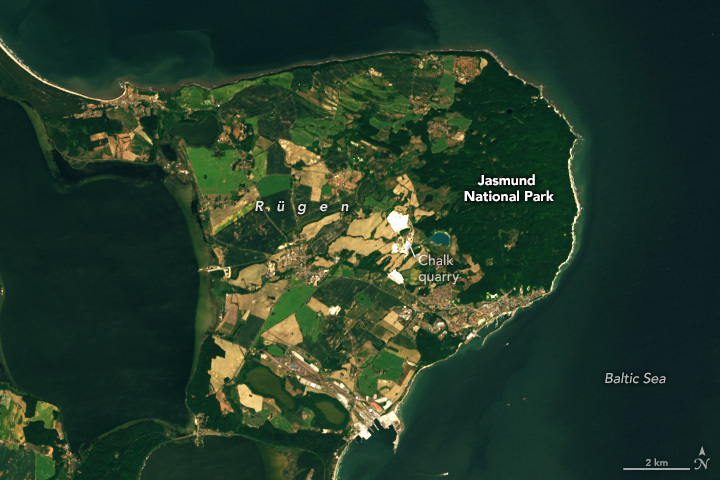
The Ancient Forests and White Cliffs of Jasmund
Downloads
- jasmundnationalpark_oli2_2023162_lrg.jpg (1483x989, JPEG)
- JasmundNP_pho_2018222_lrg.jpg (6114x4218, JPEG)
Metadata
- Sensor(s):
- Landsat 9 - OLI-2
- Data Date: June 11, 2023
- Visualization Date: June 28, 2023
Today’s story is the answer to the June 2023 puzzler.
Germany’s smallest national park occupies a distant corner of Rügen, an island in the Baltic Sea. Within this diminutive parcel, however, stands primeval beech forests with trees that are descendent of ice-age survivors. Where the forest nears the sea, the trees cling to precipitous white chalk cliffs that have captivated modern vacationers and Romantic painters alike.
This image of Jasmund National Park and Rügen’s Jasmund Peninsula was captured on June 11, 2023, by the Operational Land Imager-2 (OLI-2) on Landsat 9. Jasmund’s expanse of dark green forest stands in contrast to the lighter, geometric patterns of agricultural land, as well as the bright white patches of a chalk quarry and processing facility. The operation seen here is one of the few remaining active quarries on the island. Some abandoned quarries have naturally recolonized into biodiverse microhabitats, while others have been converted into water reservoirs or waste disposal sites.
In 2011, the European beech forest within Jasmund National Park was designated one of UNESCO’s ancient and primeval beech forests. This UNESCO network is made up of 94 sites in 18 European countries.
The European beech (Fagus sylvatica) has persisted across millennia in a range of climates. Since the end of the last ice age, beech forests spread northward across the European continent from isolated refugia in the Alps, Carpathians, and other more-southern locales. The trees played a crucial role in reforestation after the glaciers retreated.
The forests continue to evolve in response to a changing climate. An analysis of tree rings from thousands of beeches in Europe revealed that, across much of the continent, the growth rate of beech trees has declined over the past 60 years. The exception was at northern latitudes, where growth rates have risen by as much as 20 percent. In some locations—such as coastal regions in Belgium, the Netherlands, Denmark, and the British Isles—trees grew two to three times faster than in southern Europe. Modeling of forest growth under different climate scenarios shows favorable habitat continuing to shift northward and forest productivity decreasing considerably across central and southern Europe.
The forests of the Jasmund Peninsula end abruptly atop tall, bright white cliffs that plunge down to the sea. Stretching more than 8 kilometers (5 miles), Jasmund’s stunning chalk-cliff shoreline is a lesser-known relative of the White Cliffs of Dover. Both are made up of soft, porous limestone from the same rock unit.
Just as the forests evolve, the chalk cliffs also change in response to their environment. The soft white rock is prone to erosion, and the cliffs retreat tens of centimeters every year, often breaking away in large chunks. And they do not go quietly. Scientists have used seismic signals from the rocks crashing onto the beach to better understand why the cliffs fail when they do. After looking at data from 81 cliff failures over two years, they found that the events are linked to the presence of water, either following rainfall, at night when air moisture condenses, or in winter months when trees are not drawing water from the soil.
References & Resources
- del Castillo, M., et al. (2022) Climate-change-driven growth decline of European beech forests. Communications Biology 5, 163.
- Dietze, M., et al. (2020) Impact of Nested Moisture Cycles on Coastal Chalk Cliff Failure Revealed by Multiseasonal Seismic and Topographic Surveys. JGR Earth Surface 125 (8), e2019JF005487.
- Digital Geology (2021, April 15) Deutschlands schünste Geotope. Accessed June 28, 2023.
- König, P., et al. (2017) Plant diversity and dynamics in chalk quarries on the islands of Rügen and Wolin (Western Pomerania/Germany and Poland). Biodiversity Research and Conservation 14, 2908.
- Nationalpark Jasmund (2020) Welcome to the smallest german National Park. Accessed June 28, 2023.
- UNESCO Ancient and Primeval Beech Forests of the Carpathians and Other Regions of Europe. Accessed June 28, 2023.
NASA Earth Observatory image by Wanmei Liang, using Landsat data from the U.S. Geological Survey. Photograph by Moahim, cropped and used under the Creative Commons Attribution-Share Alike 4.0 International license. Story by Lindsey Doermann.
This image record originally appeared on the Earth Observatory. Click here to view the full, original record.
